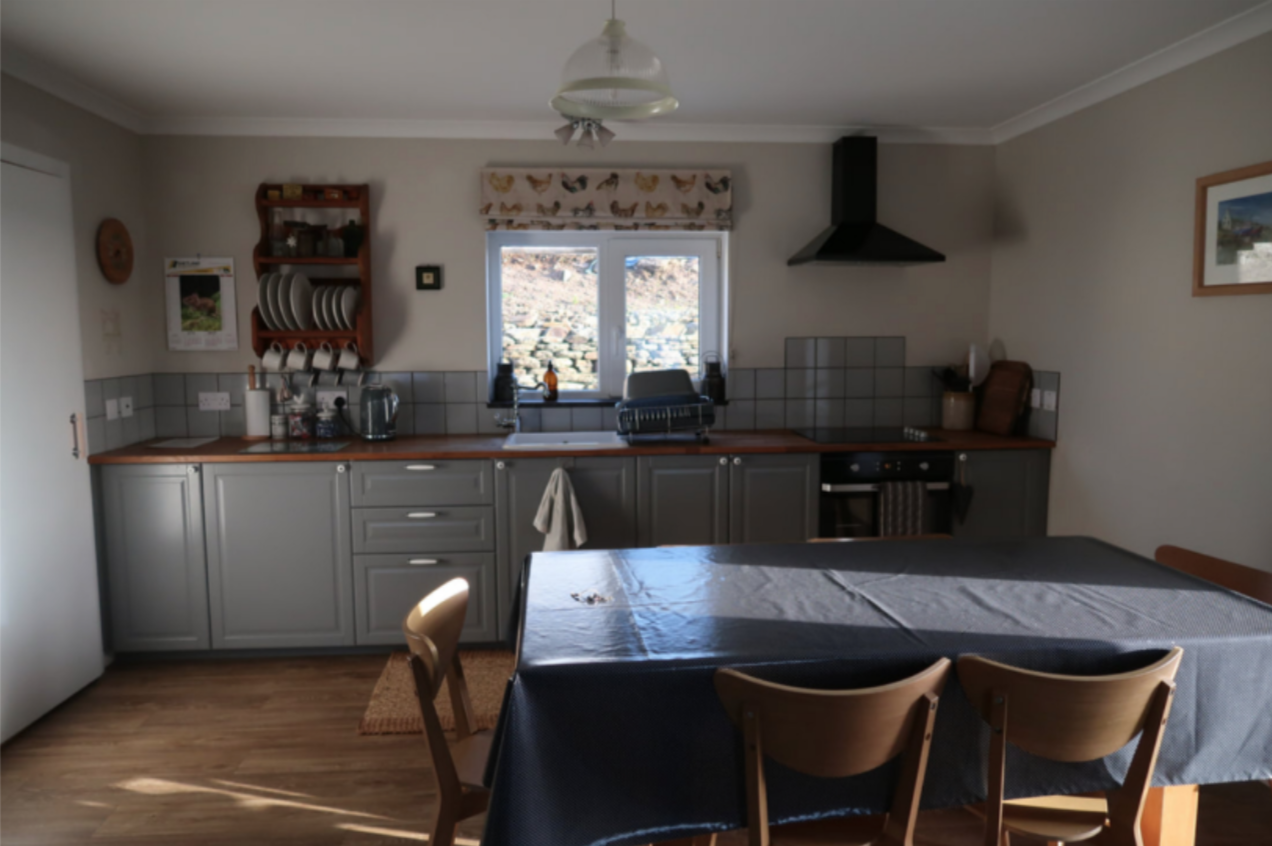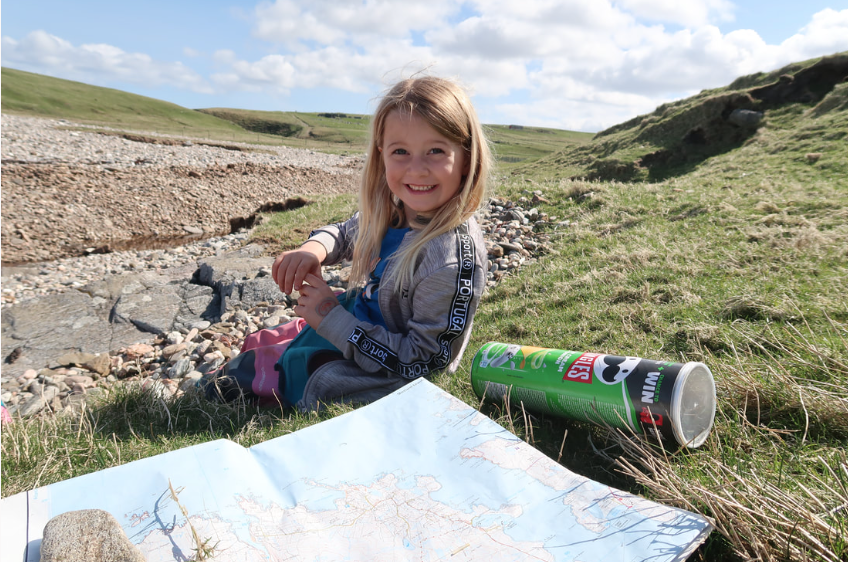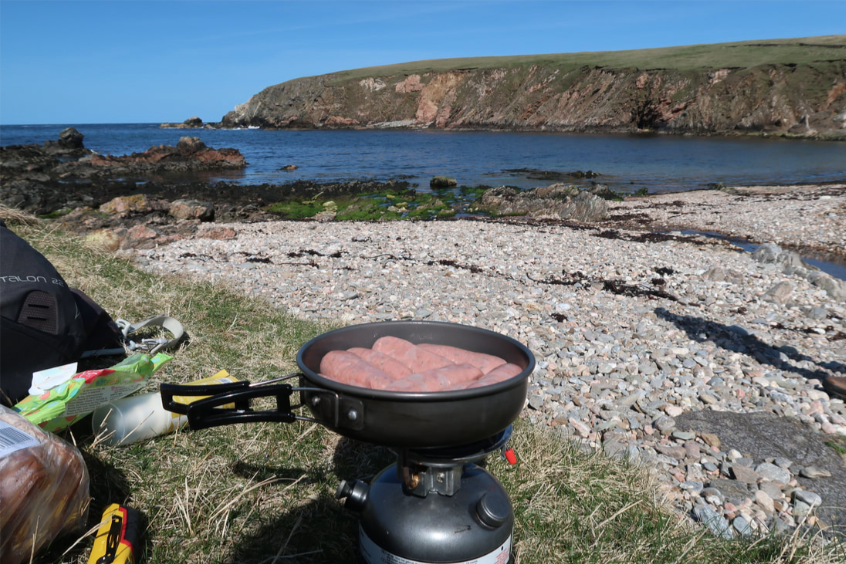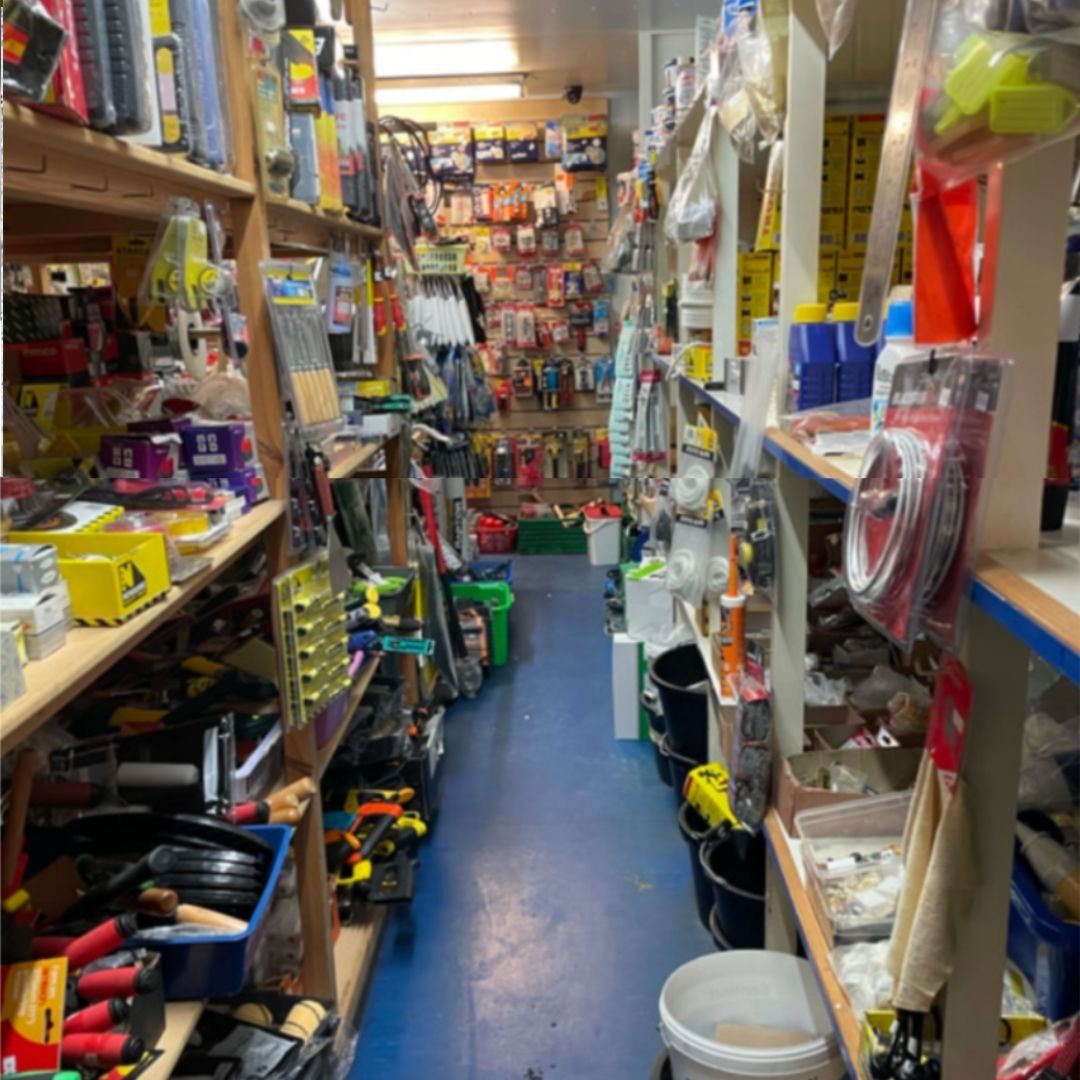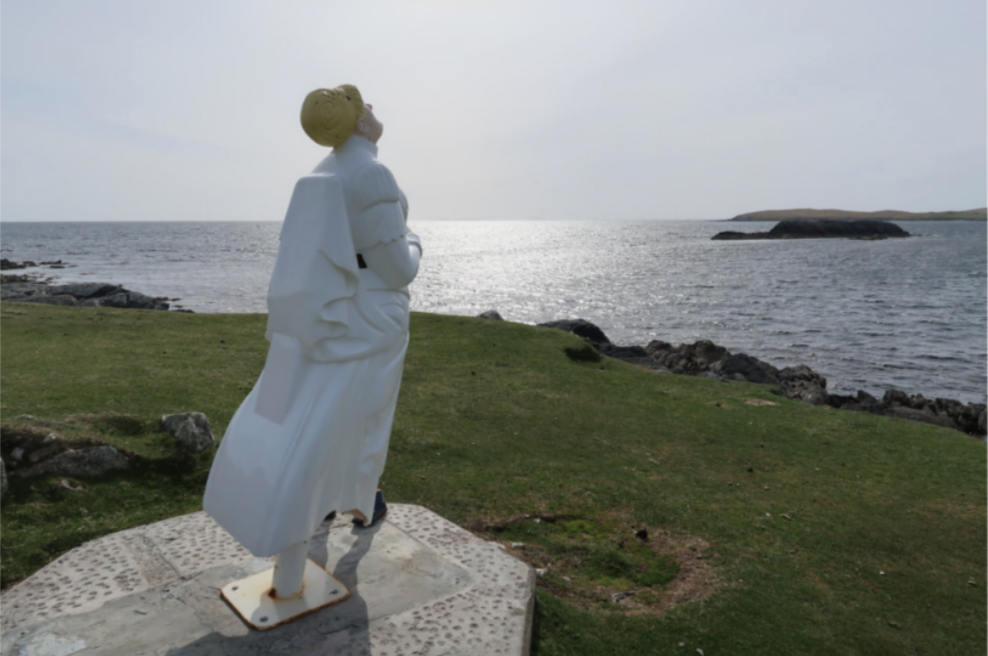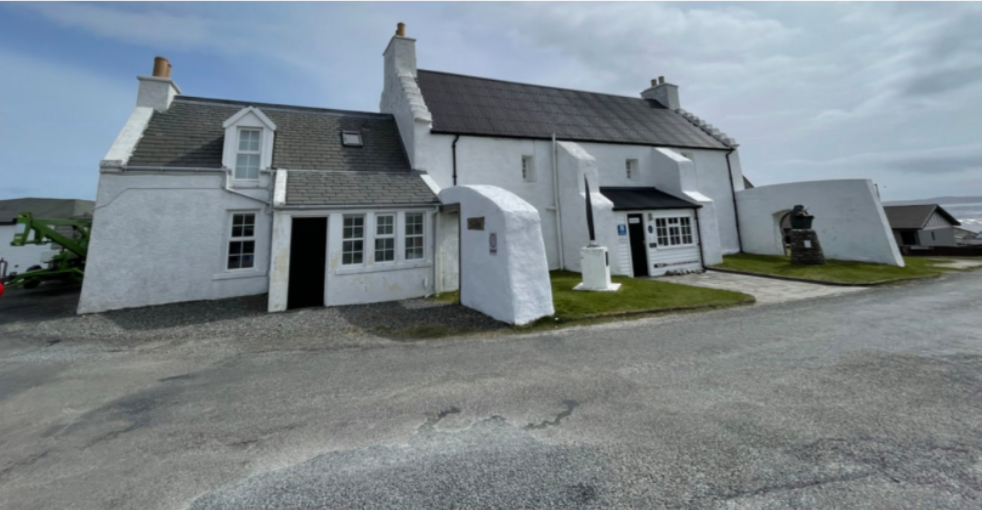Peerie Bugarth self-catering holiday home; an itinerary for your Yell stay.
The beautiful Peerie Bugarth, a gem of a property available for holiday let in Mid Yell
I often drive past traditional Shetland crofthouses and wonder what they’re like inside. These are buildings that have fascinated me since I was little. Their simple lines, symmetry, and the way they bed into the landscape almost seamlessly continues to inspire my imagination in the same – perhaps less visually attractive way – that they continue to inspire artists and poets to commit pen or paint to paper.
I couldn’t say no when Steven and Debbie invited us to Yell to enjoy a weekend in Peerie Bugarth. The house offered all the charm and beauty of a traditional crofthouse but offered the comfort and space of a modern home.
The stunning and bright kitchen at Peerie Bugarth with the evening sun streaming in the window
First off, let’s talk about the name – Peerie Bugarth.
Peerie is the Shetland name for ‘little’, and Bugarth comes from the Old Norse language and translates from: Bu, which is a stock of cattle on a farm, and gart, an enclosure. So, perhaps a cattle farm at one time in the past?
Peerie Bugarth lies tucked into the gentle slopes of Mid Yell, on the island of Yell, which is the largest of Shetland’s trio of North Isles and an island that I’ve grown to love in recent years.
Bugarth is tucked into the hillside in Mid Yell, overlooking the beautiful beach
Getting to Peerie Bugarth, Yell
Getting to Yell is easy. From Lerwick, follow the A970 and A968 for 28 miles to Toft, where you catch the inter-island ferry across Yell Sound. We went via Brae to pick up fish and chips from Frankie’s Fish & Chip Shop to eat on the ferry.
Yell is just a short hop across Yell Sound, and the modern ferry crossing takes about 15 minutes. Passengers can stand on the upper deck and enjoy views across the sound (we sat in the car and ate chips!), passing the uninhabited islands of Bigga (to the northwest) and Samphrey (to the southeast) on the way. The ferry runs about once every hour, and booking is recommended but not required.
The Yell ferry is a modern inter-island ferry which takes about 10 minutes
From Ulsta, where the ferry docks, follow the A968 for nine miles before turning towards Mid Yell (B9081). Drive through Mid Yell and take the road towards Linkshouse. Continue past the pier and turn right. Peerie Bugarth is the first on the right.
Home sweet home
Peerie Bugarth is so welcoming and we instantly felt at home
Peerie Bugarth is instantly welcoming; it’s the kind of house you’d see on a postcard or represented in a painting. Its whitewashed facade invites you inside. Stepping in the door, it’s not the cramped and crubbit interior you come to expect from these traditional old buildings, but rather, it unfolds, opening out like a flower in spring.
Inside, the property has been lovingly renovated, incorporating old and new in a seemingly effortless marriage of past and present. Jumper boards hang under Velux skylights in a house opened up to reveal the wooden beams of the vaulted ceiling. An old wooden yoke for carrying a heavy load hangs in the modern country kitchen, and, where an open hearth once stood, a freestanding cast iron stove warms the heart of the home.
But this has been no easy renovation. Old buildings are notoriously difficult to modernise, and Steven and Debbie took Bugarth right back to the front walls before painstakingly putting her back together. Originally two houses, a faux front door retains the original character of the building and conceals the modern, fresh interior. Steven spent four years painstakingly renovating it.
On arrival, the house was cosy and warm, with the embers of a fire still glowing that we stirred back to life for the evening. As we waited for the fire to take up, we walked to the beach in front of the house to enjoy the sun that was still shining. The beach in Mid Yell is somewhat unexpected, with glittering sand that sparkled and shone in the low evening sun. The tide was out, revealing the perfect ‘spoot ebb’ [a spoot is a razor clam, and an ebb refers to low tide, and I’ve never had much luck catching them, so if anyone wants to give me a lesson at da spoots, get in touch!].
Enjoying golden hour just a short distance from Bugarth
The fire was lit to welcome us
A Shetland pony greets us
After becoming acquainted with the local Shetland ponies, we made our way back to the house to cosy in for the night in front of the fire, enjoying the peace Bugarth brings the busy mind.
Peerie Bugarth has three bedrooms, all spacious and bright. There’s a double and twin room at the front of the house and, at the back, another twin. The couch in the living room acts as a sofa bed, meaning that, in total, the property could sleep up to eight people comfortably.
Interestingly, in its previous life as a but-an-ben – that’s the local name for a traditional crofthouse – it may have slept up to 15 folks, as families were big, and there may have been elderly grandparents living in the house too.
The house itself was originally two houses joined together, and the first mention I can find of it is from 1780, when a Donaldson family were recorded to live at “Bougarth, Mid Yell”. This is a loved house, and it feels loved from the moment you walk in the door.
Peerie Brugarth is a house that makes me want to explore the past – and Yell is an island steeped in history and lore, the perfect base for the dreamer inside me.
Yell is not an instant showstopper in the way places like Eshaness are, but that’s half the appeal for me. It’s an understated and proud island that quietly reveals its beauty as you become immersed in its landscape. Those who slow down, stop and spend time in Yell are rewarded with its quiet grace and gentle drama.
Spring in Yell; what a beautiful island
Saturday
With the sun shining, it was time to pack a picnic lunch, study the OS map, and set off on an island adventure. This is one of my favourite parts of staying anywhere; pouring over the map looking for features that might be worth a closer look, second-guessing the coastline and looking for prehistoric remains. Guests are invited to annotate the OS map at Peerie Bugarth with their favourite walks, and, after pondering it for a while, we decided to head north to explore Gloup and Cullivoe, the beaches and coastlines.
Gloup is 14 miles north of Mid Yell along the A968 and B9082, and B9083. We parked at the’ Fishermen’s Memorial”, where a life-size statue of a woman looking out to sea holding a baby invites visitors to stop and consider the past people who lived in this area. Below the statue are the names of the 58 men who were lost at sea in the Gloup fishing disaster in July 1881. The woman and baby on the poignant statue represent the 34 Gloup widows and the 85 children left without a father on that fateful day.
Gloup Fishermen's Memorial commemorating the Gloup Disaster of 1881.
Gloup, North Yell
Walk 1 – Gloup - Gloup Ness - Gloup
Walk distance – 2.5 miles (4 km); please note there are several fences to cross.
We began our walk at the Gloup Memorial, gingerly making our way down the steep hill towards the sandy shore below. This is a beautiful, sheltered voe with steep sides cutting a deep cleft inland towards the Mare’s Pool and further into the wild interior of this beautiful island towards the ruined houses at Heatherdale, deep inland from the open sea – a walk for another day.
Stunning views down Gloup Voe towards the Mare's Pool, North Yell
After exploring the shoreline, and a cup of tea in the warm May sunshine, we made our way north, following the coastline towards the beach at Whallerie, where we whiled away more time exploring the coast and the burn before frying up sausages for lunch. A little wren made herself known, singing in the nearby geos as we soaked up the sun’s first tangible rays of heat and warmth.
Shetland’s wren is a marvel to watch. Slightly larger than her mainland counterpart, she carries a flatter song and has become a distinct subspecies over her years of isolation.
Leaving only footprints at Gloup Voe
From here, we walked around Gloup Ness towards the headland point where a solitary wooden hut stood, tied down against the weather, looking out to sea. As we approached, a window appeared to have a man inside, motionless and still. As we got closer, we could see that it was a dummy, staged as a lookout, and the hut’s interior was decorated to make it look like a working lookout spot, guarding the seas around the north of Shetland.
Commanding views looked northeast towards Hermaness, where Muckle Flugga was visible, and a white-tailed eagle had been spotted earlier that day. The Sands of Breckon shone in the sunshine to the east, their wide sandy expanse clear under the azure blue sky.
After skirting the coastline back around to the beach at Whallerie, we followed the road back towards the fishermen’s memorial, where we’d left the car for the morning.
Walk 2 – Brough beach, Cullivoe
This walk was a distance of 1.5 miles (2.5 km).
Brough Beach, Cullivoe, Yell
We drove back towards Cullivoe and, after a quick play at the playpark beside the school, decided that we would explore the beach at Brough.
As the name suggests, the Bay of Brough was once home to an impressive Iron Age broch that now stands in ruin at the north end of the bay. These 2,000-year-old structures are dotted all around Shetland.
The best broch in Yell is found at Burraness, also in the north of the island. This 3 mile (5 km) walk from North Sandwick to the point of Burraness will take a couple of hours, and you’ll enjoy uninterrupted views across to Fetlar
I’ve written a blog about this walk that you can read here:
A walk to Burraness Broch, Yell
We walked down to the beach, passing the beautiful, now derelict house of Houll that stands above the beach.
Houll House, Brough
On the day we visited, the sun was high in the sky, the sea was turquoise blue and inviting, and the skylark sang cheerfully in the May sky, but the stony beach here gives a clue that this is a storm-battered part of the coastline, exposed to the ravages of the North Atlantic. The stones that make up the beach are driven high up the beach, forming a steep, almost fort-like wall where the winter has left its mark.
We walked to the end of the beach where an old pier stands in ruin, and a stone building is built gable on to the sea on the edge of the beach – although the gable, like the house at the north end of the beach, is now missing, washed away by time and tide. I presume that this was once a fishing booth, perhaps.
After a(another) cup of tea from the petrol stove, we made our way back towards the school where we’d left the car. An otter crossed our path from the sea on the way back, making its way to the freshwater loch to clean its pelt.
Yell is a fantastic place to view the Eurasian otter, and one of the best ways to do this is on tour with a local guide. I’d recommend Shetland Nature, who are very experienced and based in the North Isles.
Afterwards, it was time to lose an hour before our dinner booking at LJs – and where else to lose an hour than at Mary’s Aywick Shop, a veritable treasure trove of all the things you need and the things you never knew you needed!
Aywick Shop, Yell - a treasure trove of all the things you needed, and the things you never knew you needed!
I could happily spend a whole afternoon in the Aywick Shop, and indeed I have. Over the years, the shop has come in handy when visiting Yell – particularly the time I forgot to pack knickers on a caravanning holiday to the North Isles! I’m not sure what my husband thought of them, but they did the job!
After the obligatory trip to Mary’s, we had tea at LJ’s in Mid Yell. LJ’s Diner is the only place to get an evening meal, and they’re often only open till 6 pm, so it’s worth phoning ahead to check and reserve a table.
Throughout the day, serving hot food until 3 pm, Isle Eat is in the Hillshop & Cafe, also in Mid Yell. Isle Eat is one of Shetland’s best-kept culinary secrets. Offering simple breakfasts, light snacks and lunches, chef Brian adds his distinctive flair to everything coming from the kitchen, turning the most simple fare into something mouth-wateringly moreish.
We had planned to visit Isle Eat on Sunday, but a sign on the door informed us that they were closed on Sunday due to unforeseen circumstances – a reason to come back!
This photo sums up so much about our weekend in Yell
Sunday
Sunday arrived with more blue skies and the realisation that we had to check out later in the day. The wind was freshening from the southeast, and we set off early to catch the best of the day before the rain came in.
We headed south of Mid Yell towards Otterswick and parked our car at the turning point at the end of the Queyon road. From here, we did the White Wife walk.
The White Wife, Otterswick, Yell.
White Wife walk
This is a short walk along the shore until you reach the upright statue known as the White Wife. This is a ship’s figurehead from the
Bohus
wrecked off the coast here in 1924. The poignant figurehead that now acts as a memorial shows a woman clasping a bible to her chest and gazing out to sea.
Otters on display in the Old Haa
Bohus display in the Old Haa
It’s a short walk, just over half a mile there and back, but we extended it by walking to the Ness of Queyon and back along the shore towards the beach, where we had a picnic and searched for beach glass.
This isn’t one of Yell’s dramatic walks, but this understated section of coastline gave us as much joy as anywhere on that Sunday morning. As well as the jubilant wren that followed us, singing to us from every geo along the way, we also spotted an otter.
However, it’s not as the bay’s name, Otterswick, may suggest. Yes, this is a good spot for seeing the elusive Eurasian otter, and we were lucky enough to spot one amongst the low water seaweed, but the place name doesn’t come from the word “otter”.
Shetland’s place names derive from the Old Norse language. An otter, in the Shetland dialect, is called a draatsi.
As John Stewart suggests, it’s more likely that “Otter” comes from the once-popular male name‘‘Ottarr” – so this was Ottarr’s Bay.
Once we had finished the walk, the wind had picked up. The rain wasn’t far away, so we headed to the Yell Leisure Centre to swim in the fantastic swimming pool before heading on to the Old Haa Museum that opened at 2 pm with – we hoped – a fully stocked cake counter (The Old Haa’s cakes are a Yell institution, not to be missed).
Spring in Yell
Old Haa Museum
The Old Haa Museum, Yell
The Old Haa Museum is sited in a former haa house (two-storey laird’s house) dating back to the 17th century and houses the island’s museum and archive. It’s a fascinating museum stuffed with local history, inspiring displays, an archive, an exhibition space, a shop, and a small cafe selling the best locally made cakes and bakes.
The museum has a unique display honouring Yell-born naturalist Bobby Tulloch (1929-1996). He was RSPB Shetland’s representative for many years, and in 1994 he was awarded an MBE for his work on behalf of wildlife. The museum’s gardens are beautifully presented within a walled garden, largely protected from the harsh Shetland climate and lovingly tended by the volunteers who run the museum.
Bobby Tulloch Memorial
Outside the museum, a poignant memorial shows the propellor from the Catalina that crashed in the hills at Arisdale during the Second World War.
Much of the remains of the plane that claimed the lives of seven crewmen survive, and it’s a nice walk to the site where a memorial has since been erected. This is a challenging walk over heathery terrain, taking about two-and-a-half hours and covering 5 miles (8 km).
Arisdale Catalina Crash hike: Read the blog
We had an excellent stay in Yell and can’t wait to return to Peerie Bugarth in the future. The house certainly felt like a home from home, and we’d like to thank Steven and Debbie for having us and sharing their house.
To book Peerie Bugarth, click the link below.
Outdoor area at Peerie Bugarth catching the evening sun
Until next time,


